The ASUS Z9NA-D6 is a very interesting dual Intel Xeon E5-2400 series motherboard. With its dual LGA1356 sockets, the ASUS Z9NA-D6 offers options ranging from short-depth 1U rackmount enclosure options to highly expandable system configurations. This versatility comes with ASUS’ willingness to cram lots of components into an ATX size motherboard. We found that paired with low power Intel Xeon E5-2400 series processors, the ASUS Z9NA-D6 is a very strong option.
Intel Xeon E5-2400 Server Motherboard Test Configuration
I have not seen many server systems hit the market with dual Intel Xeon E5-2400 LGA1356 CPUs which made it hard to build a similar configuration. Intel Xeon E5-2600 series LGA 2011 CPUs and an associated dual socket server motherboard usually has more expansion capabilities and tends to be similarly priced. I picked the Intel Xeon E5-2430L as a low cost configuration option. We use many of the low power chips in the labs and they are great for applications like web hosting.
- CPUs: 2x Intel Xeon E5-2430L
- Motherboard: ASUS Z9NA-D6
- Memory: 6x 4GB Kingston unbuffered ECC 1333MHz DIMMs
- SSD: Corsair Force3 120GB, OCZ Vertex 3 120GB 2x OCZ Agility 3 120GB
- Power Supply: Corsair AX850 850w 80 Plus Gold
- Chassis: Norco RPC-4220
- Operating System: Ubuntu 12.04 Server and Windows Server 2008 R2
ASUS Z9NA-D6 Features
The ASUS Z9NA-D6 is an ATX motherboard. What that means is that just about any chassis one attempts to use with the motherboard will work. ASUS did need to make a few trade-offs in order to hit this form factor, but a high portion of the users will not notice a difference.
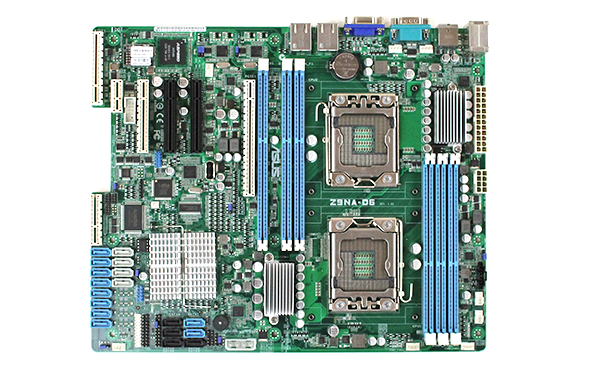
One of the biggest things that should be noted with the ASUS Z9NA-D6 is that the CPUs are in-line when cooled in a rackmount chassis. That means that air will flow from the first CPU’s heatsink to the second. With low power chips like we are using, this is not a major concern. One just needs to be mindful when selecting heatsinks and when selecting cooling. The motherboard also has a good number of PCIe connectivity.
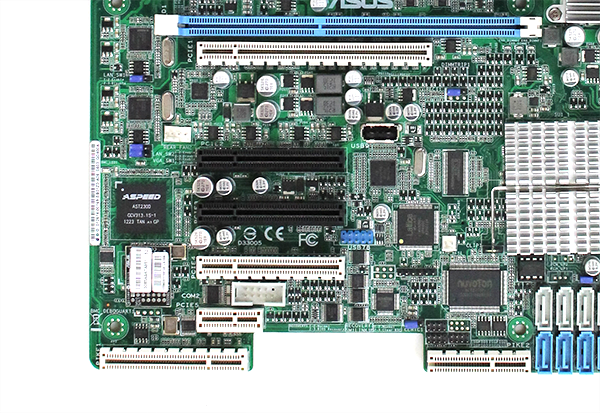
In terms of expansion slots ASUS Z9NA-D6 has a double slot PCIe 3.0 x16 slot, two PCIe 3.0 x8 slots, one PCIe 2.0 x8 (x4 electrical) slot, a PCIe x1 slot and an ASUS PIKE slot. ASUS has a proprietary form factor for add-on storage controllers called PIKE. You can see the PIKE slot at the bottom of the mainboard. The idea is you add a special SAS controller in that slot and the eight motherboard ports become active. Currently ASUS lists six controllers as supported:
[quote]ASUS PIKE SAS Controller :
ASUS PIKE 1064E 4-port SAS RAID card
ASUS PIKE 1068E 8-port SAS RAID card
ASUS PIKE 1078 8-port SAS HW RAID card
ASUS PIKE 6480 8-port SAS RAID card
ASUS PIKE 2008 8-port SAS2 6G RAID card
ASUS PIKE 2008/IMR 8-port SAS2 6G RAID card
ASUS PIKE 2108 8-port SAS2 6G RAID card[/quote]
The PIKE cards have physical drive interfaces on the motherboard PCB which is why there are so many 7-pin SATA/ SAS connectors on the ASUS Z9NA-D6.
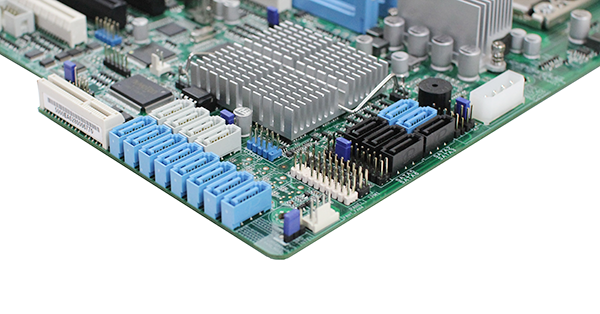
As one can see there are a total of 18 combined SAS and SATA connectors. Without the PIKE slot occupied with an 8-port controller, there are two SATA III 6.0gbps ports. Also one has access to eight SATA II ports, four from the Intel C602-A and four from the Intel SCU. Alert readers may have noticed that the USB header is not located on the bottom right of the motherboard as is often seen near the SATA/ SAS connectors. Instead it is near the PCIe slots.
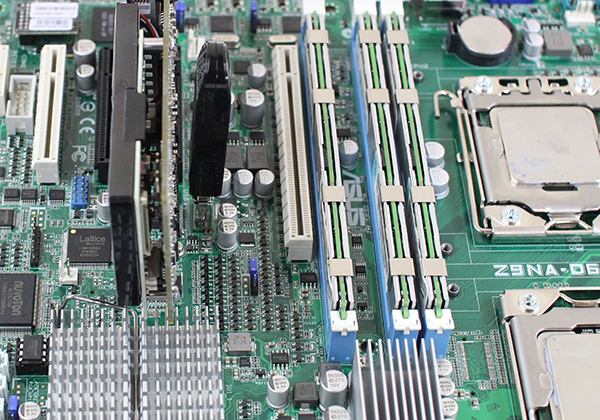
We did a quick mock-up of the motherboard for the purpose of taking pictures. The IBM M5014 with BBU was used in the x8 slot and a fairly large, 2U USB thumb drive was used in the USB slot next to it. As once can see there is enough room for these to co-exist.
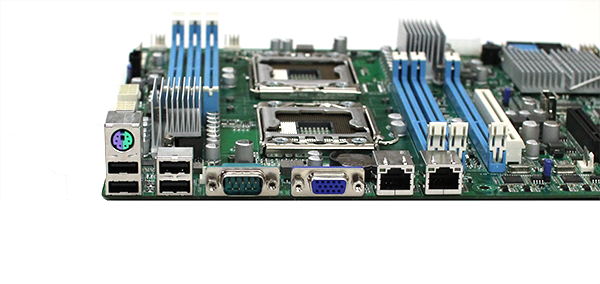
Looking to the rear of the ASUS Z9NA-D6 motherboard one can see a PS/2 combo mouse and keyboard connector. Four USB 2.0 ports. Both Serial and VGA connectors are active. one can also see two RJ-45 network ports. These are controlled by Intel 82574L controllers. It should be noted that while the ASUS Z9NA-D6 we received does have the optional ASMB6-iKVM for KVM-over-IP, there is no dedicated port.
ASUS ASMB4-iKVM Management
Remote management is virtually a must these days. Nobody has been able to provide us with exact figures, but the numbers we here are anywhere from 65% to 80%+ of servers are shipping with some sort of remote management. In the near future, we will go into depth on the solution. Needless to say, the ASMB6-iKVM module allows out-of-band management and the ability to have great control over the system.
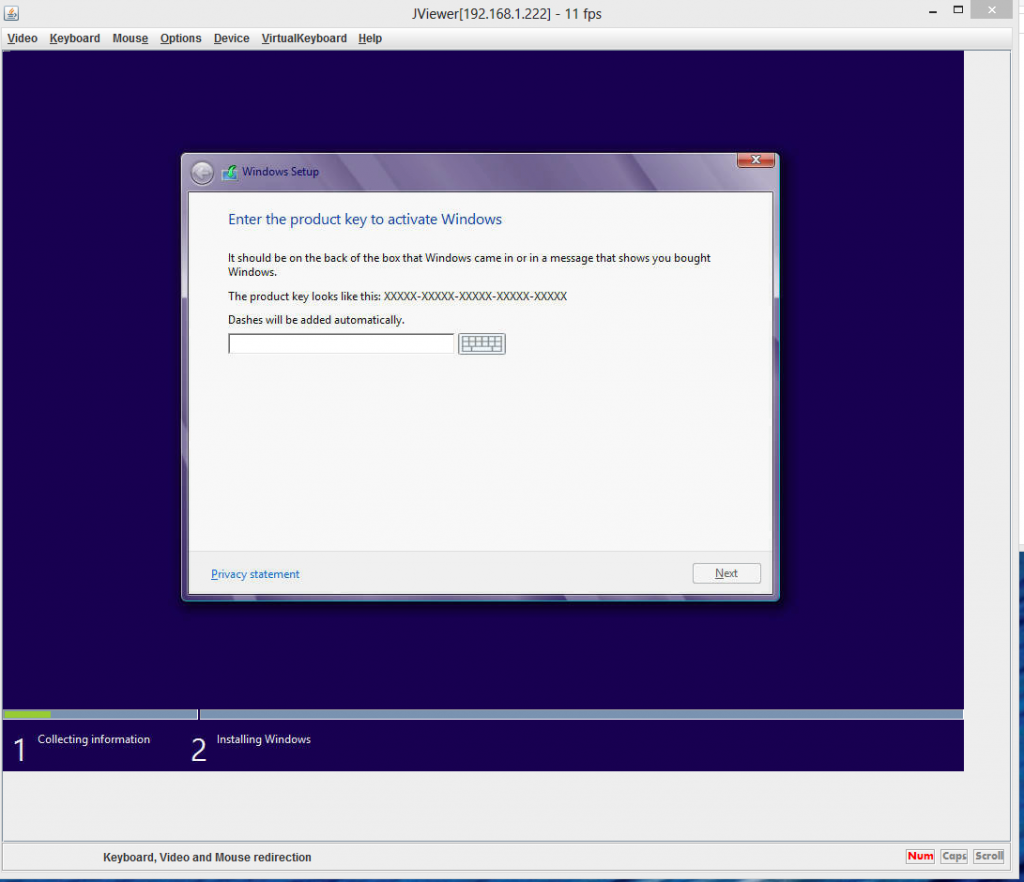
Being able to enter BIOS remotely is a key capability for IPMI 2.0 implementations and is a major driver for their popularity.
As a follow-up piece, we will look at the new ASUS iKVM interface as found on the ASMB6-iKVM.
ASUS Z9NA-D6 Warranty
ASUS offers both a three year warranty along with their 1 day advanced replacement service with the boards. The idea behind ASUS ARS is that they will process and ship a warranty item if it is in stock, within one day.
ASUS ServerCare guarantees the availability of server barebone systems and server motherboards in the ASUS warehouse to eliminate the shipping and handling charges on each order. The results are reduced shipping costs and delivery lead-time. A technical support hotline is set up in headquarter to resolve technical inquiries from partners and an A RMA (return material authorization) team, based in the Netherlands, facilitates ASUS 1-Day ARS (Advanced Replacement RMA Service) to offer efficient technical support.
Conclusion
Overall, the ASUS Z9NA-D6 is a strong motherboard, especially because it can easily fit into many short-depth 1U rackmount chassis. As a preview the new ASMB6-iKVM is much improved over previous versions. Hopefully we can take it for a spin with ASWM Enterprise and see how ASUS is enabling multiple servers to be managed at the same time.
httpvh://youtu.be/jD95EwSad7c
At first, I will admit that I did not understand the concept of the LGA1356 platform. It seemed like an update of the LGA1366 platform without the advantages of the LGA2011 platform’s extra expansion capabilities. Then through the site’s colocation adventures, we were looking solely at 60w TDP chips. When one looks at available sub 60w TDP options, it is clear the LGA1356 / Intel Xeon E5-2400 platform that the ASUS Z9NA-D6 is built around caters to lower power applications. In this market segment, the ASUS Z9NA-D6 is a strong contender.




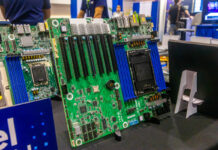
Nice board. We use a lot of short cases in our rack so we can stack on both sides. Too bad no extra ikvm nic.
Will you benchmark the CPUs? Interested in that.
Like the board. Amazing how much is crammed on there.